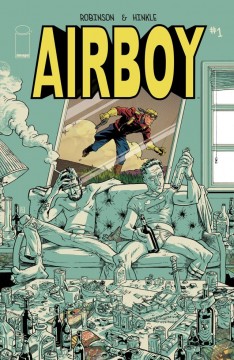Airboy #1 (Image Comics)
 If is often said that all fiction tends to be based on an element of truth, even within comics. Well, James Robinson and Greg Hinkle try and put this to the test with Airboy #1, a very fictional story about this creative team and their efforts in resurrecting a comic book character who, while once popular, has become long forgotten. Will this series prove that reality (of a sorts) is more interesting than fiction?
If is often said that all fiction tends to be based on an element of truth, even within comics. Well, James Robinson and Greg Hinkle try and put this to the test with Airboy #1, a very fictional story about this creative team and their efforts in resurrecting a comic book character who, while once popular, has become long forgotten. Will this series prove that reality (of a sorts) is more interesting than fiction?
 Publisher: Image Comics
Publisher: Image Comics
Writer: James Robinson
Artist: Greg Hinkle
Price: £1.99/$2.99 from ComiXology
Airboy #1 begins the story of ‘James Robinson’, a flagging comic book writer who feels his career is dying as he works at DC (who can blame him). However, a possible salvation comes when he is approached to write a new book for Image Comics, the only catch is that the book is a ‘reboot’ of Airboy, an obscure character from back in the day which Robinson has little knowledge of and even less love for. However, needing the money Robinson accepts the task and promptly recruits artist ‘Greg Hinkle’ before the pair start work on formulating a story – a plan which ends up with this new creative team hitting the town on a binge of booze and drugs in order to rediscover the creative flair they need.
Robinson and Hinkle have put together an incredibly humorous, if slightly disturbing, issue here as they provide readers with what feels like a truly satirical take on the comic making process. What makes it even better is the fact that both men are more than happy to make fun of themselves instead of picking on unsuspecting peers within the industry, adding to the books hilarity. Robinson writes a truly great dynamic between the fictional versions of himself and Hinkle, his counterpart coming across as bitter, cynical and tired of the rat race he is a part of while Hinkle’s is younger and more naïve, as well as making believable the circumstances the pair continue to find themselves in as they continue to take every drug and drink they can find. In fact, if there is one problem with the writing it is that Robinson did his job a little too well, having made himself too dislikeable and difficult to relate/empathize with.
Of course this is a minor quibble against the book as a whole, especially when you take into account Greg Hinkle’s phenomenal contribution here. Hinkle’s art, much like the story actually references to, is not an industry standard and as such really gives the book a whole different feel. Every panel from start to finish actually fits this story perfectly as does the use of colours throughout, which are just terrific and gel with the tone the book emits at various times, such as the duo’s drink and drugs crawl which rapidly changes colour allowing the reader to understand the chaos they are going through. Of course, there are some of the later panels which seem to slip slightly in quality, making things confusing, but this is easily forgettable when you appreciate the art of the book as a whole.
 “Airboy #1 is, put simply, a wonderfully gorgeous, guilty pleasure of a book. While it is slow burn with a not very likable lead character, it is so lovely to look at and contains so many great lines you can’t help but smile at that it will perk up even the darkest of days. This is a book that is worth a read and might also be one you come back to when you see the truly intriguing, out of left field cliffhanger it ends on. So if you fancy a book where the creators act like 70’s rock and roll singers but without the long hair, then get this book, you won’t regret it.”
“Airboy #1 is, put simply, a wonderfully gorgeous, guilty pleasure of a book. While it is slow burn with a not very likable lead character, it is so lovely to look at and contains so many great lines you can’t help but smile at that it will perk up even the darkest of days. This is a book that is worth a read and might also be one you come back to when you see the truly intriguing, out of left field cliffhanger it ends on. So if you fancy a book where the creators act like 70’s rock and roll singers but without the long hair, then get this book, you won’t regret it.”

